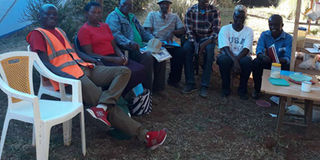Diary of a Poultry Farmer: Why quality of feed material is vital

Dr Subiri Obwogo with group of farmers from different parts of the country at his farm in Njiru in Nairobi. The poultry farmer gives insights into why quality of poultry feed material is vital. PHOTO | SUBIRI OBWOGO | NMG
What you need to know:
- Besides wrong choice of raw materials and mixing, poor outcomes on home-made feed rations sometimes result from using sub-standard raw materials.
- Protein requirements in birds and animals is expressed as Crude Protein.
- Soy bean is the world’s largest sources of plant proteins and one of the most widely used proteins source for feeds globally.
- The only way to verify is to take a sample of the materials like whole maize, fishmeal (omena), maize germ, sunflower cake or soya to a laboratory for testing.
Last Saturday, I got this email from a reader: “I’d like to visit your farm even if it means paying a gate fee!”
When I learnt that the request was from a farmer in Kamulu which is 20km or so from my farm, I agreed to the visit.
“Although I am a pig farmer,” she wrote, “I find your insights very useful for any agribusiness venture. I am preparing my feed mix but have challenges accessing quality raw materials.”
Speak of the devil and he’s sure to appear! For sure, a few hours before her email hit the server, I’d hosted a group of farmers from different parts of the country at my farm in Njiru in Nairobi.
We shared ideas on how to formulate poultry feeds at home in order to reduce cost and improve quality.
The first thing we discussed was how to tell if the raw materials are of good quality. “The only sure way to know is to test the materials in a credible laboratory,” I intimated.
But then, you also need to know how to interpret the results.
I started off by informing them that feed formulation involves sourcing different raw materials and costing them, selecting the ingredients, weighing, mixing in the right proportions, packaging and testing the quality of the final product.
To illustrate my point on the importance of using quality ingredients, I used a common phrase that I learnt some years back: garbage in, garbage out. Simply put, you reap what you sow.
I then added, “It’s not enough to only test the quality of the finished product.”
“Besides wrong choice of raw materials and mixing, poor outcomes on home-made feed rations sometimes result from using sub-standard raw materials.”
I then told them how to tell if a given raw material is of the right quality. “The only way to verify is to take a sample of the materials like whole maize, fishmeal (omena), maize germ, sunflower cake or soya to a laboratory for testing.”
I take my samples to Kalro in Naivasha and each sample is charged Sh1,000.
As a matter of fact, the next step in formulating feeds after assembling the materials is to test their quality. In order to bring the point home, I introduced the concept of “Crude Proteins” or simply “CP.”
LARGEST SOURCE OF PLANT PROTEINS
“If you don’t remember anything from this training,” I said, “Remember the word ‘CP.’”
I explained that protein requirements in birds and animals is expressed as Crude Protein. “CP connotes the total protein, including nitrogen from protein (true protein) and non-protein sources. It’s the basic nutritional requirement for any feed preparation in animals and birds.”

Test results for sampled feed ingredients sold in local outlets in Busia, Uganda. PHOTO | COURTESY
I realised that some participants were lost and I quickly turned to the table below to show them some real-life examples of how you can use CP to tell if an ingredient is of good quality or sub-standard by simply comparing the test result to the expected level.
“Most cereals and cereal by-products of grains such as maize and wheat which are the main sources of energy have a CP of about 10 per cent. On the other hand, sunflower, soya and omena, which are the main sources of proteins should have a CP value above 30, 45 and 55, respectively,” I explained.
I showed them two samples of soya meal which I’d tested previously; one fake and another of good quality with a CP of 11.6 and 40, respectively (you can’t tell the difference by simply looking).
“Soy bean is the world’s largest sources of plant proteins and one of the most widely used proteins source for feeds globally. Pure and unadulterated soy meal should have a CP of at least 45 per cent,” I pointed out.
I then told them how I had to switch from the supplier who had been selling me the fake soya at Sh56 a kilo to another supplier who was more expensive (Sh75 a kilo), but I was sure of the quality (SoG January 2, 2016) after testing it.
I gave another example of fake maize germ I had been buying. Later after realising that my chicks were not growing fast enough, I tested and found a CP of less than one (0.3). I discovered the seller was grinding maize cobs and passing it as germ. I also changed the supplier.
I could tell from the way they were nodding their heads that they’d understood the concept.
Next week I will discuss the second step in formulating poultry feeds and how tell if the mash meets the minimum standards for optimum growth and reproduction.





